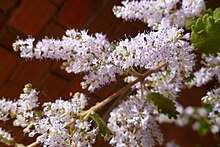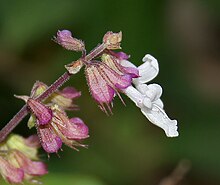Lamiaceae
| Lamiaceae | |
|---|---|

| |
| Lamium purpureum L. | |
| Scientific classification | |
| Kingdom: | Plantae |
| Clade: | Tracheophytes |
| Clade: | Angiosperms |
| Clade: | Eudicots |
| Clade: | Asterids |
| Order: | Lamiales |
| Family: | Lamiaceae |
| Type genus | |
| Lamium | |
Genera
| |


The Lamiaceae (/ˌleɪmiˈeɪsiːˌiː, -iˌaɪ/ LAY-mee-AY-see-ee, -eye)[3] or Labiatae are a
The family has a
The family has traditionally been considered closely related to the

The alternative family name Labiatae refers to the flowers typically having petals fused into an upper lip and a lower lip (labia in Latin). The
Genera



The last revision of the entire family was published in 2004.[5] It described and provided keys to 236 genera. These are marked with an asterisk (*) in the list below. A few genera have been established or resurrected since 2004. These are marked with a plus sign (+). Other genera have been synonymised. These are marked with a minus sign (-). The remaining genera in the list are mostly of historical interest only and are from a source that includes such genera without explanation.[11] Few of these are recognized in modern treatments of the family.
Kew Gardens provides a list of genera that includes additional information.[12] A list at the Angiosperm Phylogeny Website is frequently updated.[13] Plants of the World Online currently accepts 227 genera.[14]
- *Acanthomintha (A.Gray) A.Gray
- Acanthoprasium (Benth.) Spach
- *Achyrospermum Blume
- Acinos Mill., synonym of Clinopodium
- Acrocephalus Benth., synonym of Platostoma
- *Acrotome Benth. ex Endl.
- *Acrymia Prain
- Adelosa Blume, synonym of Clerodendrum
- *Aegiphila Jacq.
- *Aeollanthus C.Mart. ex Spreng.
- *Agastache Clayton ex Gronov.
- *Ajuga L.
- *Ajugoides Makino
- *Alajja Ikonn., synonym of Eriophyton
- *Alvesia Welw.
- *Amasonia L.f.
- *Amethystea L.
- *Anisochilus Wall. ex Benth., synonym of Coleus
- Apatelantha T.C.Wilson & Henwood
- *Anisomeles R.Br.
- *Asterohyptis Epling
- *Ballota L.
- *Basilicum Moench
- Becium Lindl., synonym of Ocimum
- *Benguellia G.Taylor
- Betonica L.
- *Blephilia (L.) Raf.
- *Bostrychanthera Benth., synonym of Chelonopsis
- Bovonia Chiov., synonym of Aeollanthus
- *Brachysola Rye
- *Brazoria Engelm. & A.Gray
- *Bystropogon L'Hér.
- Calamintha L., synonym of Clinopodium
- *Callicarpa L.
- Cantinoa Harley & J.F.B.Pastore
- *Capitanopsis S.Moore
- Capitanya Schweinf. ex Gürke, synonym of Coleus
- *Caryopteris Bunge
- *Catoferia (Benth.) Benth.
- *Cedronella Moench
- Ceratanthus F.Muell. ex G.Taylor, synonym of Platostoma
- *Chaiturus Ehrh. ex Willd.
- *Chamaesphacos Schrenk ex Fisch. & C.A.Mey.
- *Chaunostoma Donn.Sm., synonym of Lepechinia
- *Chelonopsis Miq.
- *Chloanthes R.Br.
- *Cleonia L.
- *Clerodendrum L.
- *Clinopodium L.
- *Colebrookea Sm.
- Coleus Lour.
- *Collinsonia L.
- *Colquhounia Wall.
- *Comanthosphace S.Moore
- Condea Adans.
- *Congea Roxb.
- *Conradina A.Gray
- Coridothymus Rchb.f., synonym of Thymbra
- *Cornutia Plum. ex L.
- *CraniotomeRchb.
- *Cryphia R.Br., synonym of Prostanthera
- *Cuminia Colla
- *Cunila D.Royen
- Cyanocephalus (Pohl ex Benth.) Harley & J.F.B.Pastore
- *Cyanostegia Turcz.
- *Cyclotrichium (Boiss.) Manden. & Scheng.
- *Cymaria Benth.
- Dasymalla Endl.
- *Dauphinea Hedge, synonym of Capitanopsis
- *Dicerandra Benth.
- *Dicrastylis Drumm. ex Harv.
- Discretitheca P.D.Cantino
- *Dracocephalum L.
- *Drepanocaryum Pojark.
- *Elsholtzia Willd.
- *Endostemon N.E.Br.
- Englerastrum Briq., synonym of Coleus
- +Eplingiella Harley & J.F.B.Pastore
- Equilabium Mwany., A.J.Paton & Culham
- *Eremostachys Bunge, synonym of Phlomoides
- *Eriope Humb. & Bonpl. ex Benth.
- *Eriophyton Benth.
- Eriopidion Harley
- *Eriothymus (Benth.) Rchb.
- Erythrochlamys Gürke, synonym of Ocimum
- Euhesperida Brullo & Furnari, synonym of Satureja
- *Eurysolen Prain
- *Faradaya F.Muell., synonym of Oxera
- *Fuerstia T.C.E.Fr.
- *Galeopsis L.
- *Garrettia H.R.Fletcher
- Geniosporum Wall. ex Benth., synonym of Platostoma
- *Glechoma L.
- *Glechon Spreng.
- *Glossocarya Wall. ex Griff.
- *Gmelina L.
- *Gomphostemma Wall. ex Benth.
- *Gontscharovia Boriss.
- Gymneia (Benth.) Harley & J.F.B.Pastore
- *Hanceola Kudô
- *Haplostachys (A.Gray) Hillebr.
- *Haumaniastrum P.A.Duvign. & Plancke
- *Hedeoma Pers.
- Heliacria Bo Li, C.L.Xiang, T.S.Hoang & Nuraliev
- *Hemiandra R.Br.
- *Hemigenia R.Br.
- *Hemiphora (F.Muell.) F.Muell.
- *Hemizygia (Benth.) Briq., synonym of Syncolostemon
- *Hesperozygis Epling
- *Heterolamium C.Y.Wu
- *Hoehnea Epling
- *Holmskioldia Retz.
- *Holocheila (Kudô) S.Chow
- Holostylon Robyns & Lebrun, synonym of Coleus
- *Horminum L.
- *HoseaRidl.
- *Hoslundia Vahl
- *Huxleya Ewart, synonym of Volkameria
- *Hymenocrater Fisch. & C.A.Mey., synonym of Nepeta
- *Hymenopyramis Wall. ex Griff.
- *Hypenia (Mart. ex Benth.) Harley
- *Hypogomphia Bunge
- *Hyptidendron Harley
- *Hyptis Jacq.
- *Hyssopus L., synonym of Dracocephalum
- Isodictyophorus Briq., synonym of Coleus
- *Isodon (Benth.) Schrad. ex Spach
- *Isoleucas O.Schwartz
- +KalahariaBaill.
- *Karomia Dop
- Keiskea Miq., synonym of Collinsonia
- Killickia Bräuchler, Heubl & Doroszenko
- Kudrjaschevia Pojark.
- *Kurzamra Kuntze
- *Lachnostachys Hook.
- *Lagochilus Bunge ex Benth.
- *Lagopsis (Bunge ex Benth.) Bunge
- *Lallemantia Fisch. & C.A.Mey., synonym of Dracocephalum
- *Lamiophlomis Kudô, synonym of Phlomoides
- *Lamium L.
- *LavandulaL.
- *Leocus A.Chev., synonym of Coleus
- *Leonotis (Pers.) R.Br.
- *Leonurus L.
- *Lepechinia Willd.
- Leptohyptis Harley & J.F.B.Pastore
- *Leucas R.Br.
- Leucophae Webb & Berthel., synonym of Sideritis
- *Leucosceptrum Sm.
- Limniboza R.E.Fr., synonym of Platostoma
- *Lophanthus Adans., synonym of Nepeta
- *Loxocalyx Hemsl.
- *Lycopus L.
- *Macbridea Elliott ex Nutt.
- *Madlabium Hedge, synonym of Capitanopsis
- *Marmoritis Benth., synonym of Nepeta
- *Marrubium L.
- *Marsypianthes Mart. ex Benth.
- +Martianthus Harley & J.F.B.Pastore
- *Matsumurella Makino
- *Meehania Britton
- *Melissa L.
- *Melittis L.
- *Mentha L.
- *Meriandra Benth., synonym of Salvia
- Mesona Blume, synonym of Platostoma
- Mesosphaerum P.Browne
- *Metastachydium Airy Shaw ex C.Y.Wu & H.W.Li, synonym of Phlomoides
- *Microcorys R.Br.
- *Micromeria Benth.
- *Microtoena Prain
- *Minthostachys (Benth.) Spach
- *Moluccella L.
- *Monarda L.
- *Monardella Benth.
- *Monochilus Fisch. & C.A.Mey.
- *Mosla (Benth.) Buch.-Ham. ex Maxim.
- Muniria N.Streiber & B.J.Conn
- Neohyptis J.K.Morton, synonym of Coleus
- Neorapinia Moldenke, synonym of Vitex
- *Nepeta L.
- *Newcastelia F.Muell.
- Nosema Prain, synonym of Platostoma
- *Notochaete Benth., synonym of Phlomoides
- *Obtegomeria Doroszenko & P.D.Cantino
- *Ocimum L.
- Octomeron Robyns, synonym of Platostoma
- *Ombrocharis Hand.-Mazz.
- *Oncinocalyx F.Muell., synonym of Teucrium
- Oocephalus (Benth.) Harley & J.F.B.Pastore
- *Origanum L.
- *Orthosiphon Benth.
- *Otostegia Benth.
- +Ovieda L.
- *Oxera Labill.
- *Panzerina Soják
- *Paralamium Dunn
- *Paraphlomis Prain
- *Paravitex H.R.Fletcher, synonym of Vitex
- *Peltodon Pohl, synonym of Hyptis
- *Pentapleura Hand.-Mazz.
- *Perilla L.
- *Perillula Maxim.
- *Peronema Jack
- -Perovskia Kar., synonym of Salvia
- Perrierastrum Guillaumin, synonym of Capitanopsis
- Petitia Jacq.
- *Petraeovitex Oliv.
- *Phlomidoschema (Benth.) Vved.
- *Phlomis L.
- *Phlomoides Moench
- *Phyllostegia Benth.
- Physominthe Harley & J.F.B.Pastore
- *Physopsis Turcz.
- *Physostegia Benth.
- *Piloblephis Raf.
- Pitardia Batt. ex Pit., synonym of Nepeta
- *Pityrodia R.Br.
- *Platostoma P.Beauv.
- *Plectranthus L.Hér.
- *Pogogyne Benth.
- *Pogostemon Desf.
- *Poliomintha A.Gray
- *Prasium L.
- *Premna L.
- *Prostanthera Labill.
- *Prunella L.
- *Pseuderemostachys Popov, synonym of Phlomoides
- *Pseudocarpidium Millsp.
- *Pseudocaryopteris (Briq.) P.D.Cantino
- Pseudochamaesphacos Parsa
- PseudodictamnusFabr.
- *Pseudomarrubium Popov, synonym of Phlomoides
- Puntia Hedge, syononym of Endostemon
- *Pycnanthemum Michx.
- *Pycnostachys Hook., synonym of Coleus
- Quoya Gaudich.
- Rabdosiella Codd, synonym of Coleus
- *Renschia Vatke
- *Rhabdocaulon (Benth.) Epling
- *RhaphiodonSchauer
- *Rhododon Epling
- -Rosmarinus L., synonym of Salvia
- *Rostrinucula Kudô
- *Rotheca Raf.
- *Roylea Wall. ex Benth.
- *Rubiteucris Kudô
- +Rydingia Scheen & V.A.Albert
- Sabaudia Buscal. & Muschl., synonym of Lavandula
- *SaccocalyxCoss. & Durieu
- Salazaria Torr., synonym of Scutellaria
- *Salvia L.
- *Satureja L.
- *Schizonepeta (Benth.) Briq.
- *Schnabelia Hand.-Mazz.
- *Scutellaria L.
- *Sideritis L.
- *Siphocranion Kudô
- Solenostemon Thonn., synonym of Coleus
- *Spartothamnella Briq., synonym of Teucrium
- *Sphenodesme Jack
- *Stachydeoma Small
- *Stachyopsis Popov & Vved., synonym of Eriophyton
- *Stachys L.
- *Stenogyne Benth.
- *Sulaimania Hedge & Rech.f., synonym of Moluccella
- *Suzukia Kudô
- *Symphorema Roxb.
- Symphostemon Hiern, synonym of Coleus
- *Synandra Nutt.
- *Syncolostemon E.Mey. ex Benth.
- *Tectona L.f.
- *Teijsmanniodendron Koord.
- +Tetraclea A.Gray
- *Tetradenia Benth.
- *Teucridium Hook.f., synonym of Teucrium
- *Teucrium L.
- *Thorncroftia N.E.Br.
- *Thuspeinanta T.Durand
- *Thymbra L.
- *Thymus L.
- *Tinnea Kotschy ex Hook.f.
- *Trichostema L.
- *Tripora P.D.Cantino
- *Tsoongia Merr., synonym of Vitex
- *Vitex L.
- *Viticipremna H.J.Lam, synonym of Vitex
- +Volkameria L.
- *Warnockia M.W.Turner
- *Wenchengia C.Y.Wu & S.Chow
- *Westringia Sm.
- Wiedemannia Fisch. & C.A.Mey., synonym of Lamium
- *Wrixonia F.Muell., synonym of Prostanthera
- Xenopoma Willd., synonym of Clinopodium
- *Zataria Boiss.
- *Ziziphora L.
Recent changes
The
Subfamilies and tribes
In 2004, the Lamiaceae were divided into seven
Phylogeny
Most of the genera of Lamiaceae have never been
| Lamiaceae |
| |||||||||||||||||||||||||||
References
- ^ a b Stevens, P. F. (July 2012). "Lamiales (Lamiaceae Family)". Angiosperm Phylogeny Website. Archived from the original on 21 March 2015. Retrieved 25 March 2015.
- hdl:10654/18083.
- ^ "Pronunciation of lamiaceae". Archived from the original on 2015-09-24. Retrieved 2014-11-25.
- ^ ISBN 978-1-55407-206-4.
- ^ ISBN 978-3-540-40593-1
- ^ "World Checklist of Selected Plant Families". Archived from the original on 2017-07-09. Retrieved 2022-02-21.
- ^ .
- ^ Cantino, P.D., Harley, R.M. & Wagstaff, S.J. 1992. Genera of Labiatae: status and classification. Pp. 511-522. In: Raymond M. Harley and Tom Reynolds (editors). Advances in Labiate Science. Richmond, Royal Botanic Gardens, Kew.
- ^ S2CID 601658.
- ISBN 978-185918-4783
- ^ "List of genera in Lamiaceae". In: "Lamiaceae". In: "List of families". In: "Families and genera in GRIN. (see External links below)
- ^ List of Genera in Lamiaceae. At: Vascular Plant Families and Genera. At: World Checklist of Selected Plant Families. At: Electronic Plant Information Center. At: Website of Royal Botanic Gardens, Kew. (see External Links below).
- ^ "APG list of Lamiaceae genera". Archived from the original on 2022-01-31. Retrieved 2022-02-21.
- ^ Lamiaceae Martinov. Plants of the World Online. Retrieved 14 April 2024.
- ^ .
- JSTOR 20649740.
- S2CID 85894904.
- PMID 33419433.
- S2CID 54808462.
- PMID 16926227.
- S2CID 24076224.
External links
 Media related to Lamiaceae at Wikimedia Commons
Media related to Lamiaceae at Wikimedia Commons Data related to Lamiaceae at Wikispecies
Data related to Lamiaceae at Wikispecies- Lamiaceae in L. Watson and M.J. Dallwitz (1992 onwards). The families of flowering plants: descriptions, illustrations, identification, information retrieval. delta-intkey.com. Archived 2022-03-02 at the Wayback Machine.
